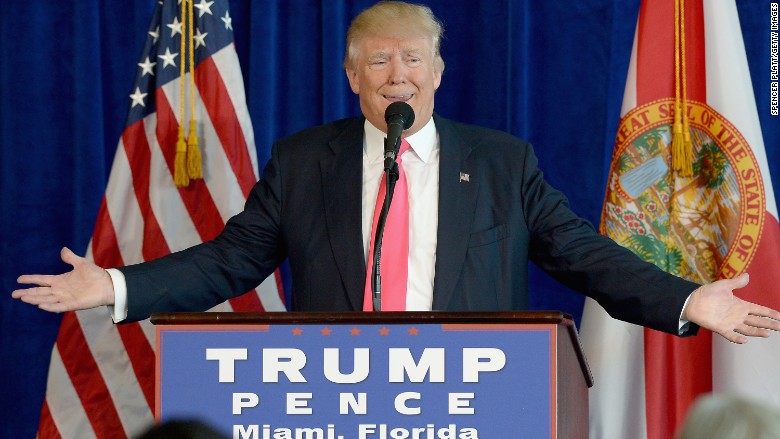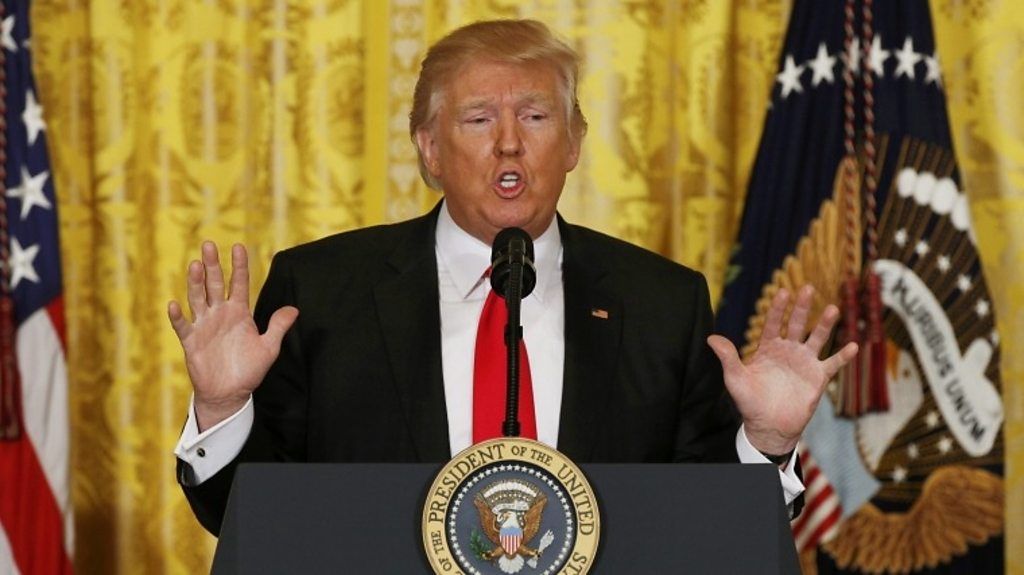Trump’s Press Conference Style and Techniques

Donald Trump’s press conferences were a hallmark of his presidency, often characterized by their unconventional nature and the president’s direct engagement with the media. His style differed significantly from his predecessors, often generating controversy and attracting significant public attention.
Language and Tone
Trump’s use of language during press conferences was often characterized by its informality, use of colloquialisms, and frequent repetition of key phrases. He often employed a conversational tone, addressing reporters directly and using personal anecdotes to emphasize his points. His language was often blunt and direct, sometimes bordering on aggressive.
“We’re going to win so much, you’re going to get tired of winning.”
This direct and often confrontational style served to create a sense of immediacy and authenticity, appealing to his base but also alienating some critics.
Controlling the Narrative
Trump actively employed strategies to control the narrative during press conferences. These included:
- Interrupting: Trump frequently interrupted reporters, often cutting them off mid-sentence or changing the subject entirely. This tactic disrupted the flow of questioning and allowed him to steer the conversation in his preferred direction.
- Changing the Subject: Trump often used the opportunity of a press conference to address topics unrelated to the initial questions posed by reporters. This allowed him to highlight his own agenda and frame the news cycle on his terms.
- Making Personal Attacks: Trump frequently attacked his critics, both within the media and within the political establishment, often resorting to name-calling and insults. This tactic served to deflect criticism and reinforce his image as a fighter against the “establishment.”
Comparison with Previous Presidents
Trump’s press conference style differed significantly from that of previous presidents. His predecessors, such as Barack Obama and George W. Bush, generally adhered to a more formal and structured approach.
- Obama: Obama’s press conferences were typically more measured and controlled, with a greater emphasis on policy and a less confrontational tone. He rarely interrupted reporters and tended to focus on answering the questions posed to him.
- Bush: Bush’s press conferences were often characterized by a more folksy and down-to-earth style. He was generally more approachable than Obama, but still maintained a more formal tone than Trump.
Trump’s style, while unconventional, resonated with a significant portion of the American public. His directness, his willingness to challenge the media, and his focus on his own agenda appealed to his base and contributed to his political success. However, his style also alienated many critics, who viewed it as disrespectful, unprofessional, and ultimately damaging to the democratic process.
The Content of Trump’s Press Conferences: Donald Trump Press Conference

Donald Trump’s press conferences were a hallmark of his presidency, characterized by their frequent occurrence, unconventional format, and often contentious nature. His approach to press conferences differed significantly from his predecessors, shaping both the public discourse and the relationship between the White House and the media.
Key Topics and Issues
Trump’s press conferences covered a wide range of topics, but certain themes emerged consistently. These included:
- The Media: Trump frequently criticized the media, labeling them “fake news” and accusing them of bias against him. He often used press conferences to attack specific reporters or outlets, further fueling tensions between his administration and the press.
- Immigration: Immigration was a central issue in Trump’s political agenda, and he often used press conferences to discuss his policies on border security, immigration enforcement, and the construction of a wall along the U.S.-Mexico border.
- The Economy: Trump frequently touted the strength of the U.S. economy, highlighting job creation and low unemployment rates. He also used press conferences to discuss his economic policies, such as tax cuts and deregulation.
- Foreign Policy: Trump’s foreign policy decisions were often controversial, and he used press conferences to defend his actions, such as the withdrawal from the Iran nuclear deal and the trade war with China.
- Political Opponents: Trump frequently used press conferences to attack his political opponents, including Democrats, the media, and other critics. He often used these events to spread conspiracy theories and misinformation.
Impact on Public Opinion and Political Discourse
Trump’s press conferences had a significant impact on public opinion and political discourse. His confrontational style and willingness to make inflammatory statements contributed to a highly polarized political environment.
- Increased Polarization: Trump’s rhetoric often intensified existing political divisions, alienating some segments of the population while solidifying the support of others. His press conferences became a platform for spreading divisive messages, further polarizing public opinion.
- Erosion of Trust in Media: Trump’s constant attacks on the media eroded public trust in traditional news sources. His claims of “fake news” contributed to a climate of skepticism and distrust, making it more difficult for journalists to report on events objectively.
- Normalization of Disinformation: Trump’s willingness to spread misinformation and conspiracy theories during his press conferences normalized such behavior in the public sphere. This had a detrimental impact on political discourse, making it harder to distinguish between fact and fiction.
Relationship to Trump’s Political Agenda, Donald trump press conference
Trump’s press conferences were not merely random events but served a strategic purpose within his broader political agenda.
- Promoting his agenda: Trump used press conferences to promote his policies, often framing them as solutions to pressing national problems. He frequently highlighted his accomplishments and downplayed criticisms, attempting to shape public opinion in his favor.
- Controlling the narrative: Trump’s press conferences were often designed to control the narrative surrounding his administration. He would frequently use these events to respond to negative news stories, divert attention from scandals, or push his own agenda.
- Building a direct connection with his base: Trump’s press conferences often appealed directly to his base of supporters, using inflammatory language and populist rhetoric to solidify their loyalty. These events served as a platform for him to connect with his followers and reinforce his message.
The Role of the Media in Trump’s Press Conferences

Donald Trump’s press conferences were marked by a highly contentious relationship with the media, characterized by both conflict and occasional cooperation. His confrontational style, frequent attacks on the press, and tendency to spread misinformation created a challenging environment for journalists.
Strategies Employed by Journalists
Journalists employed various strategies to hold Trump accountable during his press conferences. One key tactic was to challenge his claims and ask follow-up questions, aiming to elicit clarification or expose inconsistencies in his statements. This approach often led to heated exchanges, with Trump frequently dismissing or attacking reporters who questioned his narrative.
- Fact-checking: Journalists diligently fact-checked Trump’s statements, highlighting instances of falsehoods or misleading information. This was crucial in combating the spread of misinformation and providing accurate information to the public.
- Focusing on Policy: Journalists often attempted to steer the conversation towards policy issues, seeking to understand Trump’s positions and plans. This approach aimed to hold him accountable for his actions and the impact of his policies on the country.
- Utilizing Visuals: Reporters often used visuals, such as charts and graphs, to illustrate Trump’s claims and counter his narratives. This provided a more objective and data-driven perspective on the issues at hand.
Challenges Faced by Journalists
Journalists covering Trump’s press conferences faced numerous challenges, including:
- Misinformation and Propaganda: Trump’s frequent dissemination of false or misleading information presented a significant challenge to journalists. They had to diligently fact-check his statements and provide accurate information to the public, often facing accusations of bias or “fake news” from the president himself.
- Attacks on the Media: Trump regularly attacked the media, labeling journalists as “the enemy of the people” and accusing them of bias and dishonesty. This hostile rhetoric created a climate of intimidation and discouraged critical reporting.
- Disrupting the Press Conference Format: Trump often disrupted the traditional press conference format by refusing to answer questions, calling on specific reporters, or abruptly ending the event. This made it difficult for journalists to fulfill their role of holding him accountable and disseminating information to the public.
Donald trump press conference – Donald Trump’s press conferences were always a spectacle, a whirlwind of pronouncements and pronouncements, a captivating, if often chaotic, performance. Today, we see the echoes of those events in the headlines surrounding trump press conference today. Whether you agree with his policies or not, one thing is undeniable: Donald Trump’s press conferences were a force to be reckoned with, shaping the political landscape and sparking endless debate.
Donald Trump’s press conferences were often chaotic events, marked by his bombastic pronouncements and disregard for journalistic norms. It was during these events that the sharp wit and insightful commentary of se cupp became a beacon of reason and clarity, providing much-needed perspective on the unfolding events.
While Trump’s rhetoric often dominated the headlines, Cupp’s analysis offered a balanced and thoughtful counterpoint, reminding us of the importance of critical thinking and nuanced discussion in a politically charged environment.
